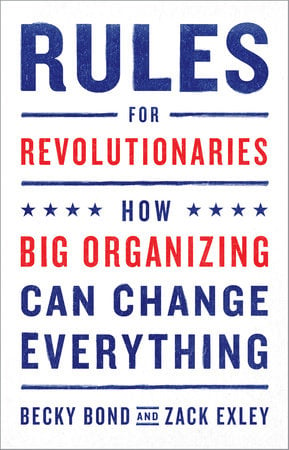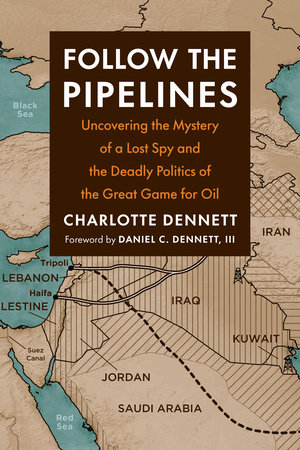You won’t have a revolution if you don’t ask for one
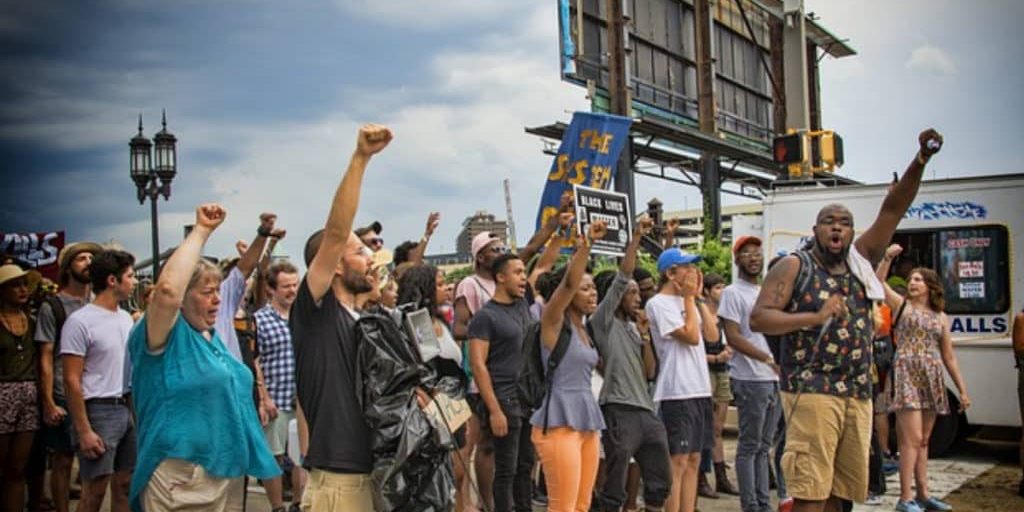
Get ready for the era of Big Organizing.
In Rules for Revolutionaries, authors Becky Bond and Zack Exley lay out the 22 Rules the fueled the Bernie Sanders campaign and which provide a way forward for activists looking for ways to move forward post-Election Day.
This model, which the authors call “Big Organizing” is the model for modern, grassroots, intersectional organizing that overturns the decades-old organizing playbook that has dominated grassroots politics and still left millions disenfranchised.
Their book offers up a narrative of how a small “distributed organizing” team operating on the fringes of the Sanders campaign was able to identify, recruit, train, and activate hundreds of thousands of volunteers to make over 75 million calls, launch 8 million individually-sent text messages, and to hold more than 100,000 public meetings in an effort to put Sanders’ revolution at the core of its campaign.
“The big vision, big goals and big organizing that these revolutionary new rules enable, that is what this book is about,” the authors write in the book. “If we put these new rules into action… then we start to win the radical changes necessary to address the pressing issues of our time.”
In this book we’re going to talk about big organizing. It’s a way to understand mass revolutionary organizing that’s relevant today. Mass revolutionary organizing is what powered virtually every transformational movement in US history from anticolonial rebellions up through the civil rights, women’s rights, and gay rights movements.
By the end of the twentieth century, however, big organizing had been almost completely supplanted by a plodding, one-by-one organizing orthodoxy that we call small organizing. The rise of small organizing is a complex story involving the professionalization of politics, attempts by the liberal establishment to channel radical impulses of working class people and people of color into incrementalist politics, and the ascendancy of a bipartisan technocratic elite in both the Democratic and Republican Parties that has been accelerating the concentration of power in the hands of an increasingly small number of mega corporations and institutions.
We believe that it’s time to get back to big organizing in a big way. It’s already happening, as evidenced not only by the Bernie Sanders campaign but also by other campaigns and movements before it, such as Obama in 2008, Occupy Wall Street, the effort to unseat George W. Bush in 2003–2004. We also see it in the immigration movement (in particular the Dreamers), the movement to defend black lives, and to some degree in movements on the right such as the campaign of Ron Paul in 2004, the rise of the Tea Party, and even some elements of the madness that was the Trump campaign.
Big organizing is what leaders do in movements that mobilize millions of people.
Not everyone in these movements is a leader, but in big organizing, volunteer leaders emerge by the thousands from every classroom, family, office and work area, neighborhood, and prison block. The movement doesn’t need to awaken or even train them—these leaders emerge ready to make change, and they bring their full selves and life experience to the task of building a movement that works. Our families, workplaces, schools, social networks, and other institutions are all inherently political. And in the current social context, people don’t need to be awakened politically—they are ready to get to work to make change.
A movement powered by big organizing provides these already existing leaders with a scalable way to make a difference that evolves and becomes more sophisticated and powerful over time. On the Bernie campaign, this looked like volunteer leaders holding phone-banking parties, staging volunteer canvasses, and holding volunteer-led mass organizing meetings. In other movement contexts, volunteer leaders would take on different “rinse and repeat” tasks.
The point is not that the revolution will be phone-banked but that the revolution will be led by volunteer leaders who take on the work of a campaign plan, a plan that is so big it can only be accomplished when everyone who wants change (a majority of the people) works together. This could be everyone on a campus, in a community, in a workplace or industry, or in the entire country.
In big organizing, leaders operate with a high level of autonomy and creativity while all working toward the same, centrally determined, shared goal. Sometimes that shared goal is decided upon by a central movement leadership and sometimes it is presented by the circumstances of history.
The team we assembled on the Bernie Sanders campaign, which came to be called the “distributed organizing team,” believed that we had to do whatever was in our power to support and grow the volunteer Bernie movement. Not only was this going to be crucial to helping Bernie win, but it was also one of our best hopes of jump-starting a resurgence of big organizing in America.
The Bernie campaign gave us a glimpse of what is possible. When Bernie called for a political revolution, the call was answered—improbably to some—by hundreds of thousands of volunteers who went to work building a voter contact machine the likes of which has never been seen in a presidential primary. This was truly big organizing. As it turned out, people were just waiting to be asked to do something big to win something big. Defying the conventional wisdom, the Bernie campaign demonstrated that the organizing sector has reached a dramatic tipping point.
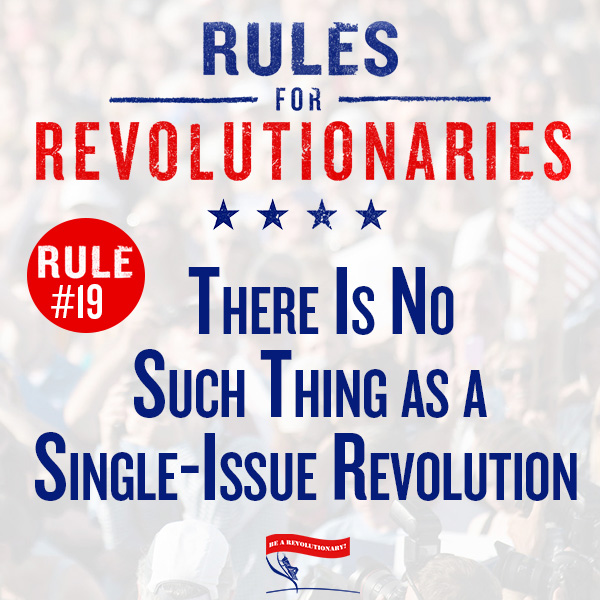
The Bernie phenomenon was even more surprising because over the past two decades most organizing at the presidential campaign level was based staunchly on small organizing. Campaign staff used data and technology to “microtarget” tiny slices of the electorate in the hopes that winning these segments would add up to a narrow majority. Once elected, these politicians promised to achieve incremental change via mundane policy tweaks. In return, they asked for only minimal participation from the people being organized.
Small organizing drives a negative feedback loop where fewer and fewer people participate because the changes promised are too small to be worth anyone’s time, leading campaigners in turn to lower their expectations of participation. Even though campaigners and policy makers are the drivers of this process, they experience it as proof of the apathy of the people. The result is that too many elected officials are basing important decisions not on what would be best for all Americans but on what they imagine would appeal to a small number of swing voters usually at the center-right of the political debate.
On the road back to big organizing, there have been some earnest attempts, fascinating experiments, and false starts. We thought we had seen big organizing emerge via digital advocacy groups that emerged in the decade following the (stolen) election of George W. Bush. These groups built huge email lists that could be contacted to raise money, collect petition signatures, or gather people together to attend protests. The organizations themselves, often with no brick-and-mortar offices, operated with small staffs and low overheads.
But the task of the staff of digital organizations (more often than not) was less about organizing the people on the other side of the emails and more about managing the list. There were some exceptions. CREDO was a bit of a unicorn: a mobile phone company that raised tens of millions of dollars for progressive groups, many of which do on-the-ground organizing. MoveOn.org raised a lot of money for candidates. And in some extraordinary moments, groups like CREDO moved in the direction of big organizing. For example, CREDO SuperPAC opened offices to help volunteers defeat Tea Party congressmen in 2012 and launched the Pledge of Resistance, organizing nearly one hundred thousand people to pledge to risk arrest to stop the Keystone XL pipeline. At the time of this writing, MoveOn.org is launching volunteer canvasses at a large scale for the 2016 general election for the first time in its history. But looking at the field more broadly, in large part, digital advocacy groups’ experiments have been limited and much more measured.
That all changed when the distributed organizing program of the Bernie campaign embraced a big organizing approach. A small hybrid team of super volunteers and professional organizers took a list of emails and phone numbers and a suite of consumer software supplemented with custom coding and built a new mass organization made up of thousands of volunteer teams with accountable leadership and measurable impact on the campaign’s aggressive goals.
This successful marriage of digital campaigning and volunteer field efforts in Bernie’s distributed organizing combined aspects of old-school organizing practices with the social platforms that provide nearly constant mediation of the way people live and work in contemporary society. It set down a new marker for organizing: harnessing a powerful, tech-enabled, people-powered model that is infinitely scalable and poses a potent threat to the status quo.
The Bernie campaign showed America that there could be another way. The big organizing that was the hallmark of the Bernie volunteer movement seeks to turn out big majorities in support of big ideas by integrating new disruptive technology into the practice of political organizing. Small organizing works well enough when incumbents want to maintain the status quo, but it isn’t big enough to challenge the establishment. Technology is now continuously revolutionizing daily life. When organizers figure out how to integrate the huge opportunities that new, social technology provides with effective peer-to-peer organizing principles and practices as part of a smart, centralized plan—that’s big organizing. And it’s the way we can win the political revolution—whether it’s in a big national fight to take control of government or in a series of meaningful local fights leading to victories that matter.
Big organizing isn’t just about the effective use of the newest technology to scale participation in politics. At the most fundamental level, big organizing is how we create campaigns that allow people to work together to realize their dreams for a more just world.
Big organizing is big in more ways than one. We have to have a meaningful message and big goals. Instead of asking for the change that politicians think is possible, we have to ask for the change that is actually needed to solve problems. This will necessarily be big.
In big organizing we have big target universes. We need to talk to everyone—not just narrow slices of assumed swing voters—about what we want to achieve. We have to get as many people as possible engaged in the work of talking with voters. We have to have voters make demands of their representatives in Congress. Together, we will constitute a wave that will swamp the influence of big money, corporate media, and other establishment players who are invested in maintaining the status quo.
What do big organizing goals look like? Make public college free. End the drug war and stop the mass incarceration of black and brown people. Let everyone enroll in Medicare and make health care truly universal. Pursue an industrial policy that seeks to put everyone to work in the best jobs possible. None of these are crazy things to ask for. And it’s not crazy to ask for them all at once. In fact, all of those things are the Status quo in almost every high– and middle–income country in the world. Bernie Sanders called for them, and he almost won the presidential primary. Our problems are big, so our solutions must be big as well. To achieve them we need a new kind of organizing, and that is big organizing.
Big organizing rarely works around a single issue. Our struggles are all connected. We can’t achieve universal health care until we have immigration reform. We can’t fix income equality until we deal with structural racism and the historical legacy of slavery. We can’t resolve national and global security issues or reach full employment without working as hard as possible to stop climate change. Big organizing also needs to have a clear and credible theory of change that explains why organizing matters. Bernie’s message was that if we wanted to win on all of the issues, we had to organize for a political revolution.
So how do we talk to everybody about our big ideas? Part of the answer is to leverage technology to talk to everyone and allow thousands to scale up into leadership roles. What that looks like is a volunteer-driven campaign with consumer software—connected by custom coding—at the center; this structure makes it possible to scale the participation of people doing sophisticated work on central plans.
Small organizing candidate campaigns depend on so-called “big data” to narrow the number of people that must be engaged with predictive modeling, micro targeting, and message testing and segmentation. Big organizing depends on technology as well, but it emphasizes a very different approach. Big organizing uses technology platforms—particularly free, consumer-oriented, social collaboration tools—to get as many people as possible engaged in executing a campaign plan and to enable those people to talk to each other and to as many voters as possible regardless of where the volunteers live or how much time they have to spend doing it each week.
In big organizing, volunteers act as the staff of the campaign. With a structure where leadership roles at nearly every level are primarily filled by volunteers, a campaign can scale up with everyone doing more and more valuable work at every level.
In contrast, a campaign that only engages volunteers in basic tasks breaks down if there’s a huge influx of people willing to help. For example, if too many volunteers show up for Get Out The Vote (GOTV), organizers run out of walk packets. Too often, they’ll send the extra volunteers to hold signs on street corners or some equally worthless task that won’t impact the outcome of the election. Big organizing demands a structure that scales. And this structure requires the ability to absorb and delegate work to volunteers at all management levels as the campaign grows.
In our corner of the Bernie campaign, we attempted to build a big organizing structure capable of accommodating limitless numbers of volunteers by combining technology with old-school, peer-to-peer organizing. The result was a national volunteer apparatus capable of distributing the work to hundreds of thousands of volunteers, giving a large number of people leadership roles, holding people accountable, and making it efficient for people to engage in high-impact voter contact no matter where they lived.
These volunteers worked in teams. The teams were led by volunteers who had proved themselves to be effective and accountable through work. It was the primary responsibility of campaign staff to recruit, empower, and grow these volunteer teams until the campaign scaled to the size necessary to win the big changes we sought.
This may sound daunting to actually accomplish, given the big numbers of people necessary to make it work well enough to win. The good news is that people are waiting for you to ask them to do something big. What we’ve learned from the Bernie campaign and many other movements is that far more people are willing to step up if you ask them to do something big to win something big than they would be if you asked them to do something small to win something small.
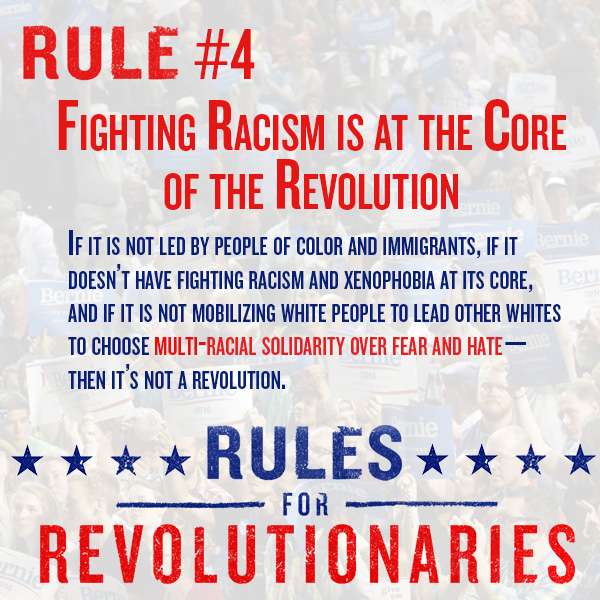
In some ways, big organizing is what populists used to simply call organizing but with the potential for much greater scale thanks to new and accessible technology for connecting people. But how did the progressive movement—including leading populists—become so focused on small organizing? To answer that, we need to introduce you to someone named Saul Alinsky and the style of community organizing that he popularized.
Saul Alinsky got his start in the shadow of the mass industrial labor movement of the 1930s. While working on his PhD in sociology in the low-income Back of the Yards neighborhood of Chicago, he participated in the birth of a community organization led by priests and other neighborhood leaders. With support from the Catholic Church and major, corporate-funded foundations, Alinsky hired organizers to launch community organizations in other cities, and eventually he formed a training school for community organizers and wrote books on his philosophy of organizing, including the now classic Rules for Radicals.
At the heart of Alinsky’s methods was the one-on-one personal relationship between the organizer and the subject who was to be organized. Through one-on-one conversations, regular people were to be enlightened to their disempowered lot by a charismatic super organizer who came in from outside of the community. In theory, the organizer gradually activated community members and built what’s called a mass power organization, the purpose of which was to move people from despair to action in small steps—climbing what the digital organizing generation would later call “the ladder of engagement”—and then to create disruptive campaigns that brought powerful forces to a bargaining table where the organizer could negotiate for incremental victories.
Rules for Radicals, which he published in 1971, encapsulates this organizing philosophy. Some of these rules are tactical and helpful to any activist, such as “A good tactic is one your people enjoy,” and “The threat is usually more terrifying than the thing itself,” and “Pick the target, freeze it, personalize it, and polarize it.”
But other parts of his philosophy are more problematic. For all the things Alinsky got right, he was explicitly looking to outflank the populist movement of his time and provide an alternative that was more palatable to the liberal elite. His funders were particularly eager to form incrementalist black and Latino organizations that would absorb, manage, and redirect the anger that was expressing itself beginning in the 1950s through urban uprisings. Alinsky disparaged the idea of revolutionary change and explicitly sought to undermine black, Latino, and working class revolutionary movements.
Alinsky believed that the purpose of building power was not to put the people in power, but to compel negotiation. He wanted to win a seat at the 1950’s and 1960’s establishment tables for the poor and disenfranchised. Part of the reason this seemed like a reasonable strategy to so many good people was that, at the time, the table was overflowing. Surely there was enough for everyone! His vision of constant campaigning was aimed at recruiting members into an organization and keeping them engaged as a noisy army that an organizer could then leverage to win as many table scraps as possible. It didn’t matter what the controversy was, just that it kept people engaged.
Alinsky’s approach was premised on the paternalistic concept that an enlightened core of outside organizers was necessary first to show the poor that there was a better way and then to represent them in a battle with elites. Rules for Radicals contains sample dialogues between organizers and poor people that would make most people today cringe.
It might seem strange that we’re spending so much time talking about a guy that many of our readers have probably never heard of, but hundreds of important organizations were founded by organizers that Alinsky hired, trained, or influenced. When we explored the backgrounds of electoral and labor organizers, we found that many of the most influential got their start with an Alinsky-descended organization. The Alinsky model simply became the standard for the entire liberal and progressive world. But it’s time to move on.
The big organizing model that can fuel revolutions believes that communities are filled with talented and intelligent people who understand what is broken and, when given material and strategic resources, can wrest power from elites and make lasting change. A political revolution is different from community organizing as we know it today.
Alinsky wrote rules for radicals. In this book, we offer rules for revolutionaries to help you learn new tactics and strategies for building a political revolution.
Recent Articles
Why is modern wheat making us sick? That’s the question posed by author Eli Rogosa in Restoring Heritage Grains. Wheat is the most widely grown crop on our planet, yet industrial breeders have transformed this ancient staff of life into a commodity of yield and profit—witness the increase in gluten intolerance and ‘wheat belly’. Modern…
Read MoreAddressing the pressing issues affecting everyday Americans is essential—and one of our nation’s most profound challenges is the devastating impact of mass layoffs. Layoffs upend people’s lives, cause enormous stress, and lead to debilitating personal debt. The societal harm caused by mass layoffs has been known for decades. Yet, we do little to stop them.…
Read MoreWhat does facing the beast mean? In this time of uncertainty, we must practice regular reflection to achieve optimal happiness and health. The metaphor below gives insight into confronting and facing it, regardless of what “the beast” is to you. The following is. an excerpt from Facing the Beast by Naomi Wolf. It has been adapted for the…
Read MoreWe’ve all heard of the phrases “time flies” and “time heals all wounds,” but what really is time, and how does it impact our lives? The concept of time may be even more powerful than we think, especially when it comes to the money we save and spend. The following is an excerpt from The…
Read More“Climate change asks us questions that climate science cannot answer,” — Dougald Hine When it comes to climate change, it seems as if there are always new questions arising: How did we get to this point? How can we stop it? What’s next? Unfortunately, there is no black-and-white, straightforward answer to any of them —…
Read More

